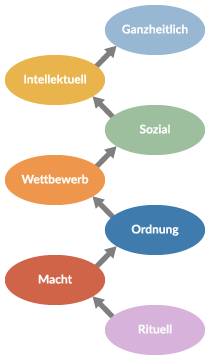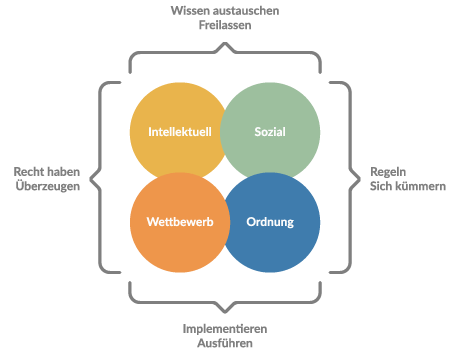Why they clash and where they strengthen each other.
Planners and project managers sometimes clash in the workplace. We are all familiar with situations where project managers eagerly start to claim employees, only to be blocked by the planner. And this is a source of irritation for both of them. In this blog, we will be looking at the drives that motivate these two roles, to gain more understanding about why they compete with each other and also to see where their middle ground is and where they can actually support each other.
Everyone is motivated in different ways. According to Clare W. Graves’ theory, people are driven by a system of ‘values’. This value system determines how you see the world (good, bad, important, etc.) and it determines how you react to problems and challenges.
First, we will briefly examine Graves’ value system and then we will create a profile of a typical planner and a typical project manager. This will show how they look at the world and where they differ from each other. Finally, we will look at how they can complement each other and how they can best get along.
7 value systems
Graves developed a theory of value systems, or drives, that explains what motivates people. You should look at the drives as a hierarchy in which the holistic drive represents the highest value system. Every adult actually carries within themselves most of these drives, but in their own unique order and with their own intensity. This explains why people act differently.
When someone does work that is in line with his drives, he does not tire easily, but is energized by the work. People with different drives, however, experience mutual tensions and irritations and often quickly develop communication problems between them. This is because everyone communicates and listens from the place of their own drives.

Purple – Ritual drive
Someone with a strong ritual drive, sees the world as unsafe and incomprehensible. He or she pays a lot of attention to rituals and the creation of set times among the group members. The people from their own circle are more important than other groups and they are prepared to sacrifice themselves for the sake of the group.
Red – Power drive
Someone with this drive sees the world as a jungle in which everyone fights for their own place. His or her aim is self-preservation and self-respect. These people are decisive, often impatient and often react quickly and impulsively. They respect power and have little faith in other authorities.
Blue – Organization drive
Someone with an organization drive sees the world as a chaotic place that must be organized. These people strive for order and certainty. They are loyal to systems and value rules and discipline. They like clear agreements and ensure that these are followed. Justice and appreciation are important to them.
Orange – Competition drive
The predominant world view here is that the world is seen as a place full of opportunities to improve your own position. Someone with the competition drive strives for results and success. They are often competitive and enjoy taking on challenges. They focus on goals and means and it is important to them to be taken seriously.
Green – Social drive
People with a strong social drive see the world as a place where all people are equal. They are socially inclined and strive for harmony between people. They are sensitive to other people’s feelings and have compassion for people that are weaker. They don’t care very much about status and money and they despise arrogance.
Yellow – Intellectual drive
In light of this drive, people see the world as a range of complex components that each have their own dynamics. People with an intellectual drive strive for knowledge and understanding of this complex world. They need freedom in how they think and what they do. They think in terms of theories and models and assess new ideas based on this.
Turquoise – Holistic drive
Someone with a holistic drive sees the world as a network of mutually independent components that together form a holistic whole. These people strive for joint solutions to global problems. They are good at putting everyday worries into perspective and are not interested in material things.
The planner
A planner focuses on creating stability and certainty. He maintains a solid resource planning system with rules and procedures and thinks everyone should follow these. A planner believes that a good work process in which everyone takes his responsibilities seriously is the basis of successful cooperation.
Motivation
The planner gets motivated when order and certainty are offered. He flourishes in an environment where the general interest is emphasized and where the right example is modeled. The planner gets demotivated when existing rules and methods are not taken seriously. He hates being late and is upset when when deviations from the agreed rules go unpunished. He is thrown off by sloppiness, people not keeping their promises and when hierarchical lines are crossed.
How they view project managers
Planners may view project managers as unpredictable and self-serving. They always care more about their own projects. Project managers put the results above the rules and that is exactly what planners can’t stand. Planners value rules over results.
Pitfall
When planners get the upper hand in an organization, you will see that a strong sense of discipline and work ethic will develop. A lot of attention will be devoted to good processes and execution of tasks. One disadvantage is that this will be at the expense of flexibility. Also, not much attention will be given to the strategic focus of the company.
Typical profile
The planner is a well-organized process monitor. Organization is his primary drive, followed by the power drive. A planner will organize the planning process efficiently and if commitments are not followed through he will be inclined to resort to using power. The drive that focuses on results (competition drive) and the social drive are not that different from each other, because the planner must ensure that the right people are chosen for the project (the result) and at the same time, the development needs of the staff must also be met (the social aspect).

The project manager
A project manager sets his goals higher than the rest. He focuses on external clients and the result that has been agreed on with the clients. A project manager sees cooperation in light of a common goal. That goal ensures that, no matter what the situation is, you know what you have to do to achieve success.
Motivation
The project manager gets motivated when opportunities for success are offered. He is prepared to take risks and likes recognition and rewards. The project manager focuses on the goals and believes that the end justifies the means. He gets demotivated when his business practice is undermined or when the goals are put up for discussion. Because the project manager is competitive, he is not comfortable about being put on an equal footing with other employees. He wants to be above everyone else and does not like it when his status and performance are disputed.
How they view planners
Project managers think planners are rigid and that they don’t understand the goals of their projects. The rules are sacred to the planners and so they often come across as the annoying police officer. This irritates the project managers, because they are doing everything they can to achieve the desired results and they perceive the planners’ micro-management as counter-productive.
Pitfall
When project managers get the upper hand in an organization you will see action that is very goal-oriented. A culture of winning and being better than others will be created. One disadvantage is that mutual competition can occur between project managers, because each project manager fights for the interest of his own project(s) and they have problems creating common views.
The number of project managers is essential in this assertion. In the blog 4 stages of resource planning, we already stated that as the organization and the number of project managers grows, an explicit need is created for a central resource planning position. 3 project managers would be able to reasonably advance the company’s interests, but that will be much more difficult for 10 project managers and they will tend to be competitive with each other.
Typical profile
The project manager is a motivated organizer. The focus on results is his primary (competition) drive, followed by the organization and power drive. A project manager will organize his project in an efficient way and when he encounters resistance he will be inclined to use force. In this profile, the power drive scores higher than the social drive, which means that he will readily enter into a conflict, regardless of the social consequences.

Conclusion
These profiles of planners and project managers are a guideline. In real life, people will show various degrees of the given behaviours, in terms of the order and intensity of drives, but they provide an overall picture.
Where they clash
In communicating with project managers, planners will always wonder “Are the agreements and rules being broken?”, while the project manager is thinking “What result will this bring? Does this contribute to the outcome?”. That leads to different behaviour and communication, which may cause tension. Becoming aware of each other’s drives is half the work of being able to work together productively.
The planner can try to put himself in the shoes of the project manager. With the focus on the result, he ultimately also serves the company’s interest. Try to give the project manager the feeling that you are collaborating with him and sharing ideas. The project manager, in turn, should realize that the planner is bound to certain rules in the interest of the entire company. You might be able to convince them to bend the rules a little bit, but respect the absolute boundary they have set for themselves.
Where they can support each other
Even though the planner and the project manager have different profiles, which can cause them to clash in communication, they are definitely not polar opposites. After all, they both have the organization drive in their profile. Although this takes second place for the project manager, it is a necessary drive for the project manager to be able to manage his projects, so that he can achieve the desired result. He will therefore be able to recognize and respect the planner in that organization drive.
Of course, it has been shown that some drives can complement each other quite well and are therefore a good combination, depending on the required skills. In the world of planning and executing projects, the emphasis is on execution. In that light, you can see in the figure below that the competition drive and the organization drive are actually a good match.

A planner can really complement a project manager and support him in organizing his project. The project manager, in turn, can help the planner to see actions in light of the desired results. By joining forces, they can figure out the best ways to utilize available employees to ensure maximum project results.
When there is good collaboration between planners and project managers, we get the best of both worlds: a goal-oriented organization with strong discipline in the execution. Take a look for yourself in your own company: do the planners and project managers actually have a profile with the appropriate drives? After that, pay attention to the awareness of planners and project managers of each other’s drives (by getting them to read this blog, of course).





